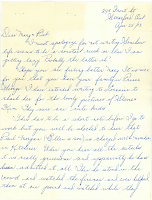DIY Genealogy: Saving Letters - Why Do It?
A Family of Letter-Writers.
In this first post in a mini-series on saving letters, I describe my philosophy and summarize my method for saving inherited family letters. My goal for saving letters? To improve being able to access the data they contain in order to use that data for family research.
I come from a family of letter-writers. At first puzzled about what to do with the box of family letters I inherited -- but sensing their potential -- over the years I sought advice on how to "deal" with inherited documents like letters. I took what resonated with my own situation and materials and incorporated it into my personal method for creating and maintaing a family archive.
Disclaimer: I am a genealogy enthusiast not a professional genealogist or archivist; as such, a professional's methods may differ from mine, or may be more comprehensive. If you have something in your family collection that you are unsure about or you think might need particular care, I encourage you to seek out the services of professionals.
That said, for my modest family collection of contemporary letters in reasonably good condition, the following steps summarize my personal method for saving my inherited family letters:
- cataloguing each letter;
- scanning each letter and its envelope;
- transcribing each letter; and
- storing original letters in my personal family archive.
My Personal Philosopy On Saving Letters.
Why do I save letters?
My maternal grandmother came from a large family in Ontario, Canada. They maintained close family ties despite the distances separating them as many moved "out west" and lived their lives -- helped in large part by the lost art of writing letters. I inherited my grandmother's letters (a product of her generation, she kept everything -- much to the delight of this family historian!) and although the writers and recipeints passed away decades ago, their voices remain alive in a treasure-trove of personal family information, stories, and local events.
But other than enjoying learning about the inner workings of my grandmother's family, one might ask what is the point of saving these letters? Other than for the sake of "posterity," could letters actually be useful as a research tool? Is it worth investing the time and effort to catalogue, scan and transcribe them? For me, the answer is a resounding YES.
These letters are an untapped storehouse of a wide range of informaton. Each letter is a snapshot, like a photograph, rich in layers of detail about the world these people lived in, their interests and priorities as they moved through life, their family connections, their own sense of history, and their unique personalities and foibles.
My goal in preserving my family's letters is to unlock and tap into the information contained in them. In doing so, the letters transform from a secret vault that no one visits to an accessible research resource rich with information to suit the diverse interests of the family historian.
Being the archivist of my letter collection.
In an earlier DIY Genealogy post Start Organizing With Logs, I walked through my method for how I organize the various materials in my personal family collection. The principles for sorting and logging my family's collection of letters is the same. But because I wanted to be able to use the letters' contents for research, that meant keeping in mind additional considerations about the relevant details I might want to record about each letter in my family collection catalogue spreadsheet.Being the archivist of my collection of letters meant considering what data to record about each letter that might be relevant, significant, or important for:
- being used as a resource for my research projects (both current and at the concept stage);
- preservation, storage, and being prepared for loss of the originals; and
- making life easier for whoever inherits my family archive collection after I am gone.
A little effort put into sorting, logging, transcribing, and preserving the letter collection now will go a long way to ensuring they don't become someone else's headache.
For example, what situation is more likely to increase the risk of family letters getting thrown out, as being seen only as "old family junk my weird aunt collected":
- 50-year-old letters from people no one has heard of found in a dusty, forgotten old cookie tin stored on a shelf in the back of a closet; or
- 50-year-old letters from people no one has heard of found in a library storage box, each in their own folder, complete with a list of the letters containing highlights about each one's contents.
Even if the physical letters do eventually get thrown out due to space limitations, or some disaster happens like a fire or flooding, by going through this process, a record of the letters will still exist and they can continue to be a research resource for future generations.
Stay Tuned For Posts On Each Step.
In writing this post, I discovered there was too much to say on the topic of saving letters to do it justice in a single post (one that people would actually read, that is!). I decided to break out the steps, discussing each step in its own post. So please check back for future posts in the Saving Letters mini-series! First up is "Step 1 - Cataloguing Letters."

Comments
Post a Comment